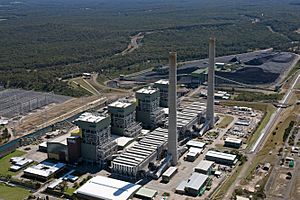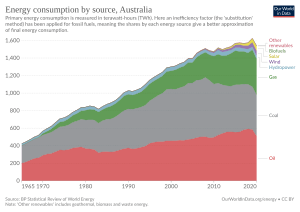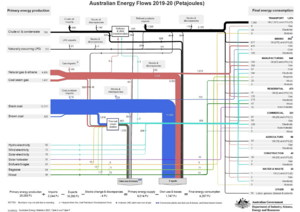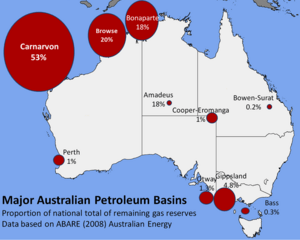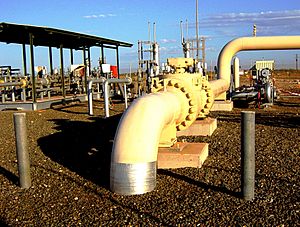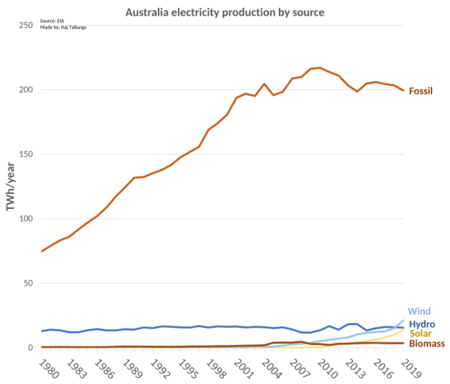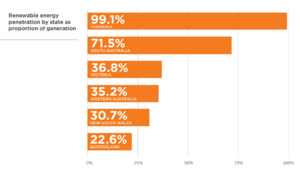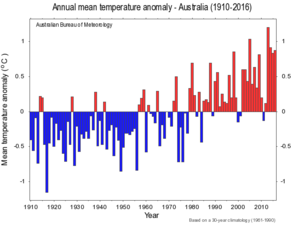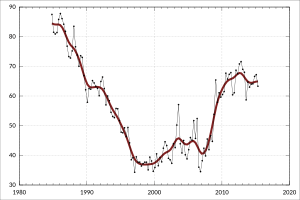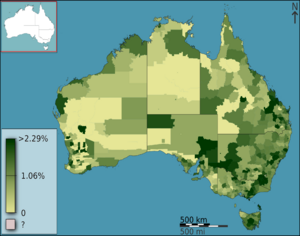Energy in Australia facts for kids
Energy in Australia is all about how Australia produces and uses energy and electricity. This energy is used by people and businesses, or it's sent to other countries.
In 2021, Australia sent out more energy than it used. It exported a lot of liquefied natural gas (LNG), coal, and other minerals.
Most of Australia's energy comes from coal and natural gas. But because of global warming and climate change, Australia is now using more renewable energy sources. These include solar power and wind power. In 2022, renewable energy made up almost 36% of all the electricity made in Australia.
Contents
How Australia Uses Energy
In 2009, Australia had the highest amount of carbon dioxide (CO2) emissions per person in the world. This means each person in Australia produced more CO2 than people in other countries. Back then, Australia released about 20.58 tons of CO2 per person each year.
However, Australia has worked to reduce these emissions. From 1990 to 2017, the amount of CO2 per person dropped by a third. This was the lowest it had been in 27 years!
What Fuels Australia?
Coal
Australia is a big producer of coal. In 2015, it was the fourth-largest producer of a type of coal called anthracite (black coal). It was also the biggest exporter of coal, sending out 33% of all the coal traded globally.
In 2021, Australia was the fifth-largest producer of hard coal in the world. Coal is still very important for Australia's energy. It made up 64% of the energy produced in Australia and 53% of its electricity.
Most of Australia's hard coal mines are in Queensland and New South Wales. Another type of coal, called lignite (brown coal), is mainly found in Victoria.
Natural Gas
Australia has a lot of natural gas. The biggest gas areas are in Western Australia, the Northern Territory, Victoria, and Queensland. In 2014–2015, Australia produced 66 billion cubic metres of natural gas. Most of this came from Western Australia and Queensland.
Australia also produces liquefied natural gas (LNG), which is natural gas cooled down to a liquid so it can be easily shipped. In 2004, Australia exported 7.9 million tons of LNG.
In 2021, natural gas was a big part of Australia's energy. It made up 29% of the energy produced and 19% of the electricity generated. Natural gas is used most for making electricity and heat, and also in factories.
Oil
Australia's oil production reached its highest point in 2000. After that, it started to decrease. This means Australia now has to import more oil from other countries. By 2006, Australia was importing 39% of the oil it used. This is because older oil fields are producing less, and not many new ones are being found.
In 2021, oil made up 52% of all the energy Australia used for things like transport. It also contributed to 4% of Australia's energy production and a small part of its electricity generation. Most of the oil used in Australia (about 65%) goes into transport, like cars and trucks.
Oil Shale
Australia has a lot of oil shale, which is rock that contains oil. It's estimated to have 58 billion barrels of oil in these rocks. Most of these deposits are in eastern Queensland. Australia used to mine oil shale between 1862 and 1952.
From 2000 to 2004, a project near Gladstone, Queensland produced over 1.5 million barrels of oil from oil shale. However, as of 2021, Australia no longer produces oil from oil shale for business.
Uranium
Australia has many Uranium deposits. However, Australia does not have any nuclear power plants that use uranium to make electricity.
Electricity in Australia
Since 2005, Australia has been making more and more electricity from wind power and rooftop solar power. These are types of renewable energy. Because Australia is such a large country, it doesn't have just one big electricity grid that covers everything.
Australian Electricity Generation by Type FY 2022-2023 Black Coal (35.0%) Natural Gas (17.8%) Brown Coal (11.5%) Oil (1.8%) Solar (15.3%) Wind (11.4%) Hydro (6.1%) Bio Energy (1.1%)
Electricity Supply
From 2003 to 2013, the price of electricity for homes in Australia went up by about 72%. This was mainly because a lot of money was spent on building and improving the electricity networks. However, experts think that prices will not go up as much in the future. This is because of new rules and more competition in the electricity market.
In 2021, Australia made a total of 265 Terawatt-hours (TWh) of electricity. Most of this came from coal (52.9%) and natural gas (18.8%). Renewable sources like solar (10.5%), wind (9.3%), and hydro (5.6%) also contributed a lot.
Renewable Energy
Australia has a lot of potential for renewable energy. Wind and solar power have been the fastest-growing energy sources in Australia recently. Making 50 megawatts of wind power, which is enough for about 21,000 homes, creates about 50 construction jobs and five permanent jobs.
Geothermal energy, which uses heat from inside the Earth, is also growing. However, it currently makes up only a small part of Australia's energy.
Energy Efficiency
Using less energy could save Australia a lot of money. According to EnergyAustralia, it could save A$25 billion, or about A$840 for each electricity customer. This shows how important it is to use energy wisely.
Climate Change and Energy
In 2007, Australia produced 396 million tons of CO2. At that time, Australia was one of the top countries for CO2 emissions per person. Each Australian produced about 18.8 tons of CO2, which was much higher than the average in Europe (7.9 tons).
Because of climate change, Australia is expected to have more extreme weather events. This includes more bushfires and floods during summer. Rising sea levels are also a big worry for Australia, as most of its population lives near the coast.
Jobs in the Energy Sector
The electricity and gas supply industry is one of the smaller industries in Australia when it comes to jobs. In November 2017, about 75,400 people worked in electricity and gas supply. This was about 0.67% of all jobs in Australia. Many of these jobs were for truck drivers, electricians, and electrical engineers.
Jobs in Renewable Energy
In 2015–16, about 11,150 people worked full-time in renewable energy in Australia. Most of these jobs were in building new renewable energy facilities. However, the number of jobs went down after 2012. This was mainly because fewer rooftop solar panels were being installed on houses. Once a renewable energy plant is built, fewer people are needed for ongoing maintenance.
Most jobs in renewable energy in Australia are related to solar power. In Western Australia, 93% of all renewable energy jobs are in solar. In Queensland, many jobs are in biomass energy, which uses things like sugar cane to make electricity. In Tasmania, most renewable energy jobs are in hydropower, which uses water to generate electricity.
Experts predict that jobs in renewable energy will grow a lot by 2030. This is because more electricity will be needed, and more renewable energy plants will be built. On the other hand, jobs at coal-fired power stations are expected to decrease as these older plants close down. While some areas might lose coal jobs, it's expected that many more jobs will be created in renewable energy.
Australia's Energy Policy
Finkel Report
In June 2017, a report called The Independent Review into the Future Security of the National Electricity Market (also known as the Finkel Report) was released. This report suggested ways to make Australia's energy supply more secure and reliable. It aimed for more security, future reliability, benefits for consumers, and lower emissions. The report suggested a "Clean Energy Target" (CET) to encourage more renewable energy.
Many scientific experts liked the Finkel Report. They praised its national plan for clean energy, its focus on helping customers, and its goal to keep politics out of energy decisions. They also liked that it considered current technologies and market forces to help Australia meet its climate goals.
National Energy Guarantee
In October 2017, the Australian Government decided not to use the Finkel Report's Clean Energy Target. Instead, they proposed something called the National Energy Guarantee (NEG). This plan aimed to lower power prices and prevent blackouts. It asked electricity companies to meet certain requirements for reliability and emissions. Companies would need to provide a minimum amount of steady power from coal, gas, or hydro, while also providing a set amount of low-emission energy.
Some people criticized the NEG, saying it moved away from renewable energy. In October 2018, the Australian Government announced that it would not continue with the National Energy Guarantee.
Carbon Tax
On 1 July 2012, the Australian Federal government introduced a carbon tax. This tax charged A$23 for every ton of CO2 produced by large industrial companies and government groups. To help people with this tax, the government lowered income tax and increased pensions.
A report in 2014 said that the carbon tax had helped reduce carbon emissions by as much as 17 million tons. It was especially good at reducing pollution from the electricity sector.
However, on 17 July 2014, the government at the time removed the carbon tax. Australia became the first country to get rid of a carbon tax. In its place, the government set up the Emission Reduction Fund.


